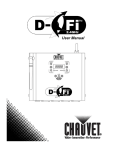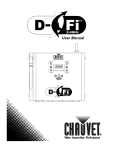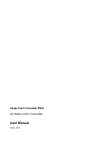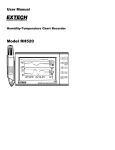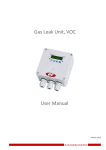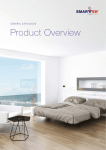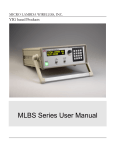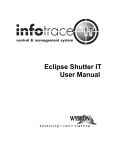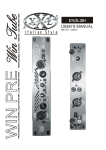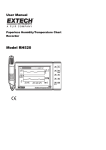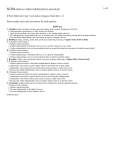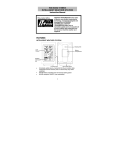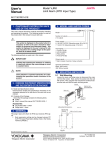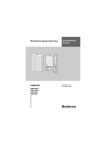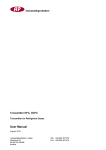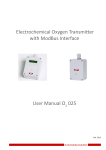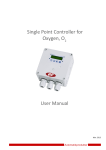Download 3. Vario-Sense® CO-Busmeßkopf 2
Transcript
BIO - IAQ Sensor for Indoor Air Quality Metal Oxide Indoor Air Quality (VOC) Sensor User Manual October, 2014 AUTOMATIKPRODUKTER IAQ Indoor Air Quality Sensor BIO 010 Oct. 14 1 Intended Use ........................................................................................................................................3 2 Functional Description .......................................................................................................................3 2.1 2.2 2.3 2.4 2.4.1 2.4.2 3 VOC Sensor ................................................................................................................................3 VOC Measurements ....................................................................................................................3 Temperature Measurement (option)............................................................................................4 Functions .....................................................................................................................................5 Sensor Function.....................................................................................................................5 Controller Function................................................................................................................6 Installation............................................................................................................................................7 3.1 Mounting Instructions ..................................................................................................................7 4 Electrical Connection ..........................................................................................................................7 5 ModBus ................................................................................................................................................8 5.1 5.2 5.3 5.4 5.5 5.6 5.7 General ........................................................................................................................................8 Physical Port ................................................................................................................................8 Time Response ...........................................................................................................................8 ModBus Functional Description ...................................................................................................9 Troubleshooting .........................................................................................................................10 ModBus Register Description ....................................................................................................11 Overview ModBus Functions .....................................................................................................13 6 Commissioning .................................................................................................................................14 7 Specifications ....................................................................................................................................15 8 Figures................................................................................................................................................16 9 Notes and General Information ........................................................................................................19 9.1 9.2 9.3 10 Installers’ Responsibilities .........................................................................................................19 Maintenance ..............................................................................................................................19 Limited Warranty .......................................................................................................................19 Part Disposal......................................................................................................................................19 2 AUTOMATIKPRODUKTER IAQ Indoor Air Quality Sensor BIO 010 Oct. 14 IAQ Indoor Air Quality (VOC) Sensor 1 Intended Use The BIO IAQ air quality sensor with digital processing of the measuring values and temperature compensation is used for measuring and controlling the air quality in indoor areas within environmental conditions specified in the Technical Data. The intended sites are all areas being directly connected to the public low voltage supply, e.g. residential, commercial and industrial ranges as well as small enterprises (according to EN50 082). The BIO IAQ sensor must not be used in potentially explosive atmospheres. The sensor must only be employed in areas within the environmental conditions as specified in the Technical Data. Electronics can be destroyed by static electricity. Therefore, do not touch the equipment without a wrist strap connected to ground or without standing on a conductive floor (acc. to EN 61340-5-1). 2 Functional Description 2.1 VOC Sensor The semi-conducting metal oxide sensor measures the electrical conductivity of the nanocrystalline metal oxide coated on a heatable substrate. The typical operating temperature is between 300 and 400 °C. The doping of the metal oxide with noble metals results in a positive sensibility to combustible gases like VOCs, carbon monoxide and natural gas. The doping permits the adaptation to the demands of the measuring task. VOCs are partially or totally burnt at the sensor surface by the oxygen of the metal oxide. The electrons released in the semi-conductor by this process lead to an increase of the electrical conductivity. At the end of the combustion process, the metal oxide returns to its initial state by incorporating oxygen from the air, with the conductivity also adopting the initial value. The change of the conductivity is evaluated via the internal micro-controller and output as a standard signal. 2.2 VOC Measurements The VOC content in indoor areas is mainly determined by the persons present and their activities. See table 1. When for example working with cleaning agents or when cooking, VOCs (Volatile Organic Compounds) are set free, but also human respiration is a constant source of volatile metabolism products (VOCs). The air quality sensor detects the increasing VOC level and calculates the proportional CO2 value. The VOC/CO2 correlation was determined by taking measurements under real conditions. See diagram 1. To this day, there aren’t any standard signals for the VOCs; therefore the IAQ air quality sensor reduces the measured VOC values to CO2 equivalents with the unit ppm. This grants the compatibility to existing CO2 ventilation standards. Each time the IAQ air quality sensor is switched on, it runs through a warm-up period of 20 minutes. During this warm-up period there aren’t any measurements; the sensor outputs the signal of 80% of the measuring range. After the warm-up period, the sensor interprets the currently read VOC value as zero-point, independently from the actual concentration. An internal algorithm continuously updates the zero-point by taking the lowest measured VOC value. Therefore the ambient air should be of low VOC content after the warm-up period. This can be obtained by shortly venting when starting the measurements with the 80% signal. If the sensor isn’t started at low VOC concentrations, it can take a couple of days until the internal algorithm has updated the zero-point so far that effective measuring results are available. The natural sensor drift and ageing is corrected by the implemented control algorithms. 3 AUTOMATIKPRODUKTER IAQ Indoor Air Quality Sensor Indoor Air Contamination Source BIO 010 Typical Substances Emission Source VOCs Oct. 14 Ventilation Others Acetone, Ethanol, Isoprene CO2 Humidity Nonanal, Decanal, α-Pinene *Skin respiration & transpiration Humidity *Flatus Methane, Hydrogen Human Being *Cosmetics Limonene, Eucalyptol *Household Supplies Alcohols, Esters, Limonene Unburnt Hydrocarbons *Combustion CO (Engines, Appliances, Tobacco CO2 Smoke) Humidity *Paints Formaldehyde, Alkanes, *Adhesives Alcohols, Aldehydes, *Building Material *Solvents Ketones, Siloxanes *Furniture *Carpets *Office Equipment *PVC Toluene, Xylene, Decane +Consumer Products *Printers/Copiers, Benzene, Styrene, Phenole Computers *Breath demand controlled permanent (5-10%) Table 1 – Typical indoor air contaminants (VOC and others) VOCs CO2 Window opened/closed Odors VOCs 0 CO2 1hr 2h 3h 4h Diagram 1: Correlation CO2- VOC (records from a business meeting session) 2.3 Temperature Measurement (option) The temperature measurement is done via an internal sensor. The signal is output as a linear 0 – 10 V signal. A customer’s application with passive signal is possible as an option. Additional heat sources in the flash-mounted box have an influence on the temperature measurements and have therefore to be avoided. 4 AUTOMATIKPRODUKTER IAQ Indoor Air Quality Sensor 2.4 BIO 010 Oct. 14 Functions 2.4.1 Sensor Function The IAQ sensor shows the VOC value (0 – 4000 ppm or 0 – 2000 ppm) in form of a 0- 10 V signal at the analog output AO1. The temperature (0 – 50 °C) is also available as a 0 – 10 V signal at the analog output AO2. In ModBus operation, the VOC value is displayed at the read register 01 and the temperature value at the read register 02. The IAQ sensor offers a great number of options. The function can be defined according to the application via the ModBus interface by means of the ModBus function diagram (fig. 5). The definition of the function can be provided in the factory as well as on site by using the ModBus tool. Option Setpoint Potentiometer The temperature output can be adjusted by ± 3 °K. Option Digital Output DO1 The digital output is activated in dependence of the programming via the following functions. • Depending on the VOC value via the internal switch threshold (threshold = write register 03) • Depending on the temperature value via the internal switch threshold (threshold = write register 03) • Switch threshold can be selected via internal potentiometer. • Via digital input 1 or 2. • Via the operation mode switch. Option Digital Output DO2 Function is the same as for digital output DO1. The digital output DO2 takes the place of the analog output AO2, meaning that with two digital outputs, there is only one analog output available. Option Status LED 1 The Status LED is activated in dependence of the programming via the following functions. • Via digital input 1 or 2. • Via the operation mode switch. • Via digital output 1 or 2. • ModBus command. Option Status LED 2 • Function the same as for Status LED 1 Option Operation Mode Switch The switch activates the digital outputs (DO1/DO2) and/or the status LEDs (LED1/LED2) in dependence of the programming. Option IAQ Power The IAQ Power Module offers a 230 VAC supply voltage for the IAQ sensor. A wet switch contact (230 V) is available in addition. The switch contact is activated via the digital output DO1. The IAQ Power Module is mounted in the in-wall box. See fig. 10 and 11. 5 AUTOMATIKPRODUKTER IAQ Indoor Air Quality Sensor 2.4.2 BIO 010 Oct. 14 Controller Function The standard control function described here can be changed via the ModBus interface by means of the ModBus function diagram (paragraph 5.7). Air quality control function The controller outputs the control signal (AO1 / 0- 10V) within the defined control range of 700 to 1200 ppm in dependence of the VOC concentration. The output signal is suppressed for all values below 700 ppm in order to grant a dead band. The green LED is on for “good air quality”, that means the measured VOC value is < 700 ppm. The orange LED is on for „bad air quality“, meaning that the measured VOC value is > 700 ppm. The control parameters are factory-set, but can be adjusted to the application via ModBus. Temperature control function The pre-set temperature of 21°C can be changed via the potentiometer by +/- 3°K. When the function “heating” is selected and the temperature falls below the set value, the PID controller delivers a signal at the analog output (AO2/ 0-10V) until the desired temperature is obtained and keeps this temperature up. The function of the air quality control (AO1) is blocked when the temperature falls below the set minimum temperature of 18°C. When the measured temperature exceeds the set maximum temperature of 26°C (+ summer DIN increase), the air quality control is forced to 100% (10 V at the output). The control parameters are factory-set, but can be adjusted to the respective configuration via ModBus (see point 5.6 and 5.7). Fig. 1: Output signal VOC control Option Status LED Option Betriebsarten Schalter Potentiometer intern IAQ IAQ IAQ Option Sollwert Potentiometer Fig. 2: Views: Sensor Complete version Internal potentiometer 6 AUTOMATIKPRODUKTER IAQ Indoor Air Quality Sensor BIO 010 Oct. 14 3 Installation 3.1 Mounting Instructions When choosing the mounting site please pay attention to the following: • Do not mount the sensor next to doors, windows, air inlets and outlets. • Free air supply must be granted. • Vertical mounting (air inlet at the sensor down/up) • Avoid direct sunlight. • No heat sources around in case of temperature measurement. 60mm Recommended mounting height is 1.0 m (3 feet) to 1.5 m (5 feet) above floor. 83,4mm • = 3mm 60mm 78,3mm Fig. 3: Mounting IAQ Sensor For IAQ-Power Module see also fig. 10 and 11 4 Electrical Connection • Installation of the electrical wiring should only be executed by a trained specialist according to the connection diagram, without any power applied to conductors and according to the corresponding regulations! • The connection is done via screw-type terminals with a section of 0.25 to 1.5 mm2. • The connection of the different applications is shown in the figures 7 to 11. • Avoid any influence of external interference by using shielded cables for the signal line, but do not connect the shield. • For ModBus wiring we recommend using the cable Y(St)Y 2x2x0.8 LG, in line topology and without any branch lines. Please consider in addition all regulations concerning the wiring of RS-485 field bus wiring. 7 AUTOMATIKPRODUKTER IAQ Indoor Air Quality Sensor 5 BIO 010 Oct. 14 ModBus 5.1 General The ModBus protocol was developed for the data exchange between information processing units, programmable logic controllers and other intelligent systems. A master computer communicates with maximum 247 connected devices via a serial data link of RS-485 standard. There is only one device (host, master) per bus line determining the telegramming. The other devices (clients, slaves) only react on the request of the master and are never allowed to send data on the bus line without request of the master device. The data are transmitted in form of data telegrams. There are two possible formats within the ModBus protocol, the ASCII and the RTU format. Only the RTU format is used and described in here. The RTU telegram settings don’t include any tag delimiters. The beginning and the end of data telegrams are realized by short stops. The syntax is as follows: Address Command Data CRC16 The data are transmitted with binary code. The address and the command are 1 byte each. When requested from the master, the data may contain for example address, order and the initial address and the number of data to be retrieved. The answer from the slave is structured in the same way. The data may contain, besides the address and the order, for example the number of sent data bytes and the data. CRC16 is a 2-bytes Cyclical Redundancy Check. The end of the data telegram is recognized if there is an idle period of minimum 2 characters. The slaves react to valid requests after a certain timeout after receipt of the last character by giving the corresponding answer. The master then expects the start of the answer. If it doesn’t come, the master can occupy the bus anew and give new commands. The slave answers after a silence of 3.5 characters at the earliest. In case of transmission errors or not executable commands, the slave doesn’t answer or respond with an error message (see troubleshooting). 5.2 Physical Port The communication between master and slaves uses a serial data link of RS-485 standard. The port settings are as follows: 9600 Baud, 5.3 1 Start Bit, 8 Data Bits, Parity none, 1 Stop Bit Time Response Transmission telegram: The master can start a data exchange. The master sends a data telegram to a slave containing: • Address of the slave • Function requested from the slave (order) • Data field (variable depending on the order) • Control characters The slave starts uploading a telegram after each idle period of 3.5 characters. If the first character is the slave’s own address or the address 0 (all), it processes with the telegram. If there is a silence of 2 characters at least, it considers the telegram finished and checks the CRC. If the telegram is without errors, it executes the function and composes an answer. 8 AUTOMATIKPRODUKTER IAQ Indoor Air Quality Sensor BIO 010 Oct. 14 Answer telegram: • Address of the slaves • Executed function (order) • Data field (e.g. data length and data) • Control characters The answer is sent at the earliest after a silence of 3.5 characters after the end of the master’s telegram. In case of an error, the slave waits for the end of the telegram and the period of 3.5 characters, and then returns an error message. The master awaits the answer of the slave or a timeout (see table) before starting a new exchange in order to avoid complications resulting from mutual transmissions. Data organization The devices offer properties and states generally described here as objects. These objects can be asked specifically as bit or byte ranges by the master and changed by it. An input object can only be read. An output object can be read or written. ModBus functions The following functions are available with the communication protocol ModBus: • The main functions granting the data exchange. • The additional functions for the control and the diagnosis of the data exchange. The table below indicates the functions managed here. The functions “Read” and “Write” refer respectively to the action of the master. Function 5.4 Description Implemented 03 Reading of N output registers Yes (max 32 reg.) 16 Writing of N output registers Yes (max 22 reg.) ModBus Functional Description Function 03: Reading of N output registers This function enables to read the output registers; these are the registers the master can read or write in the slave. This function enables to read the input registers; these are the registers the master only can read. Example: Reading of N registers; function 3 Request: Slave address 1 - 254 Function 03 Start address Number of words CRC16 1 Byte 1 Byte 2 Bytes 2 Bytes 2 Bytes Slave address 1 – 254 Function 03 or 04 Number of sent bytes Data CRC16 1 Byte 1 Byte 1 Byte n Bytes 2 Bytes Answer: 9 AUTOMATIKPRODUKTER IAQ Indoor Air Quality Sensor 5.5 BIO 010 Oct. 14 Troubleshooting If there is any parity, framing, overrun or CRC error during receipt of a telegram, the slave doesn’t accept and answer it. If the slave cannot execute the requested order, it sends an error message. Format of an error message: Slave address 1 - 254 1 Byte Answer code: Answer code Error code CRC16 1 Byte 1 Byte 2 Bytes Order function code + 0x80 (the most significant bit is set to 1). 10 AUTOMATIKPRODUKTER IAQ Indoor Air Quality Sensor 5.6 BIO 010 Oct. 14 ModBus Register Description Register 0 1 2 3 4 5 6 7 8 9 10 11 12 13 14 15 16 17 18 19 20 21 22 23 24 25 26 27 28 29 30 31 Read register Request with command 0x03 Description Range Sensor type (defined by product type) Measured value VOC 0- max (defined in register 11) Measured value Temperature 0- max (defined in register 12) PID output value VOC 0-10000 PID output value Temp -10000 to +10000 PID sign Temp +1 = heat; -1 = cool res res res Potentiometer position 0-10000 Own MODBus address 1-255 Measuring range VOC 0-32767 Measuring range Temp. 0-32767 (50 with 1 decimal place) Alarm threshold 1 0- max (defined in register 11 o 12) Alarm threshold 2 0- max (defined in register 11 o 12) Hysteresis 1 0- max (defined in register 11 o 12) Hysteresis 2 0- max (defined in register 11 o 12) Max-temp_limit 0- max (defined in register 12) Min-temp_limit 0- max (defined in register 12) Ao1 switch 0-6 Ao1_Do2 switch 0-21 Do1 switch 0-21 PID kp parameter PID ki parameter PID kd parameter PID setpoint VOC PID- setpoint Temp. res LED1 switch 0-24 LED2 switch 0-24 Day/ night setback value 0- max (defined in register 12) Relay status of Bus 0-3 Write register Command with command 0x10 (16d) Register Function Possible Range Sensor MODBus 0 address 1-255 1 Measuring range VOC 0-32767 2 Measuring range Temp. 0-32767 (50 with 1 decimal place) 3 Alarm threshold 1 0- max (defined in register 11 o 12) 4 Alarm threshold 2 0- max (defined in register 11 o 12) 5 Hysteresis 1 0- max (defined in register 11 o 12) 6 Hysteresis 2 0- max (defined in register 11 o 12) 7 Max-temp_limit 0- max (defined in register 12) 8 Min-temp_limit 0- max (defined in register 12) 9 A01 switch 0= OFF 1= ACTUAL VOC 2= ACTUAL Temp 3= PID Heating 4= PID Cooling 5= PID Heating + Cooling 6= PID VOC 7= PID VOC (acc. to DIN) Default 19505 254 2000 500 100 Dep. on version Dep. on version Dep. on version 10 40 10 Dep. on version Dep. on version Dep. on version Dep. on version Default Note 254 2000 500 1000 500 1 VOC 11 AUTOMATIKPRODUKTER IAQ Indoor Air Quality Sensor 10 A02_D02 switch as analog out 2 0= OFF 1= ACTUAL VOC 2= ACTUAL Temp. 3= PID Heating 4= PID Cooling 5= PID Heating + Cooling 6= PID VOC 7= PID VOC (acc. to DIN) 11 D01 switch (Function depending on version) 12 13 14 15 16 17 18 19 20 21 PID kp parameter PID ki parameter PID kd parameter PID setpoint VOC PID setpoint Temp res LED1 switch 0= OFF 11= ACTUAL VOC 12= ACTUAL Temp 13= PID Heating 14= PID Cooling 15= PID Heating + Cooling 16= PID VOC 17= DI1 18= DI2 19= Switch position 1 20= Switch position 2 21= Switch position middle 0-100 0-100 0-100 0- max (defined in register 11) 0- max (defined in register 12) 0= OFF 17= DI1 18= DI2 19= Switch 1 20= Switch 2 21= Switch middle 22= Bus_Di 23= Dig Out 1 24= Dig Out 2 25= Invert. LED2 LED2 switch 0= OFF 17= DI1 18= DI2 19= Switch 1 20= Switch 2 21= Switch middle 22= Bus_DI 23= Dig Out 1 24= Dig Out 2 25= Invert. LED1 Day/night setback value 0- max (defined in register 12) 0-3 (1= LED1, 2= LED2, Relay status of Bus 3= both) BIO 010 as digital out 2 (optional) 11= ACTUAL VOC 12= ACTUAL Temp. 13= PID Heating 14= PID Cooling 15= PID Heating + Cooling 16= PID VOC 17= DI1 18= DI2 19= Switch pos. 1 20= Switch pos. 2 21= Switch pos. middle Oct. 14 4 TempCooling 0 free 10 40 10 1200 210 0 0 5 12 AUTOMATIKPRODUKTER A> B A< B OR MAX [4]Temp PID out 0 0 11 12 13 14 15 16 0 1 2 3 4 5 6 [10] Ao2 + Do2 Switch 3-step Switch optional [20] Setback A-B 17 18 19 20 21 0= OFF 11= ACT. VOC 12= ACT. Temp 13= PID Heating 14= PID Cooling 15= PID Heat+cool 16= PID VOC 17= DI1 18= DI2 19= Swtich 1 20= Swtich 2 21= Swtich middle 11= ACT. VOC [4]Switch 12= ACT. Temp level2 13= PID Heating 14= PID Cooling [6]Hysteresis2 15= PID Heat+cool 16= PID VOC 17= DI1 18= DI2 19= Swtich 1 20= Swtich 2 [3]Switch 21= Swtich middle level1 [5]Hyster. 1 0= OFF 0-10V 1= ACT. VOC 2= IST Temp 2-10V 3= PID Heating 4= PID Cooling 5= PID Heat+cool 6= PID VOC 0= OFF 0-10V 1= ACT. VOC 2= IST Temp 2-10V 3= PID Heating 4= PID Cooling 5= PID Heat+cool 6= PID VOC In > switchl In > switchl 0 0 Jumper 5 ON=2-10V LED 1 optional optional Digital Out 1 Digital Out 2 21 22 23 24 LED 2 OFF 17= DI1 18= DI2 19=Switch 1 20=Switch 2 [19]LED1 Sch. 21=Switch middle 0 22=Bus_Di 17 23=Dig Out 1 18 24=Dig Out 2 19 optional 20 0 17 18 19 20 21 22 23 24 [18]LED1 Sch. OR OR Analog 2Out 0/2-10V Analog 1Out 0/2-10V BIO 010 AUTOMATIKPRODUKTER [21]Bus_DI [16]TempSoll 0 11 12 13 14 15 16 [11] Do1 Switch [8]Tempmin [7]Tempmax Soll [14] KD Act.> Set PID Controller Act.< Set [13] KI 0 Digital In 2 Su IST [12] KP Act. > set PID Controller Act. < set 0 1 2 3 4 5 6 [9]Ao1 Switch Digital In 1 +-10% 0-100% [2]Temp Soll IST 0 17 18 19 20 21 Potentiom. optional [2]TempMeas. Range TEMPActual value optional [15]VOCSetpoint [1]VOC 2011.04 [3]VOC PID out 5.7 [1]VOCMeas. Range VOCActual value VOC Functional diagram Version V7 IAQ Indoor Air Quality Sensor Oct. 14 Overview ModBus Functions Fig. 5: Functional diagram 13 IAQ Indoor Air Quality Sensor BIO 010 Oct. 14 6 Commissioning General • Check mounting location. • Check power voltage at the terminals 1 (+) and 2 (GND) at X2. Operation mode sensor • Check output tensions 0 – 10 V. • Check digital output • Option internal potentiometer: Check/ adjust switch threshold at the internal potentiometer. • Option IAQ Power Module: Check fan activation by lowering the switch threshold to 450 ppm. Operation mode ModBus • Addressing in the operation mode ModBus (see point 5, ModBus) • Check/ adjust the parameters. See read-write register. • Check VOC value at the read register 01, temperature value at the read register 02. Operation mode control • Check/ adjust the parameters. See read-write register. • Check output control signal(s). 14 AUTOMATIKPRODUKTER IAQ Indoor Air Quality Sensor BIO 010 Oct. 14 7 Specifications Electrical Supply voltage Power consumption VOC sensor data Gas type Sensor element Measuring range Accuracy Repeatability Response time Warm-up time Expected life time Temperature sensor data Sensor element Measuring range Accuracy Output signal AO1 = analog, VOC 0 – 4000 ppm AO2 = analog, temperature 0 -50 °C DO1 = digital Ambient conditions Humidity Temperature operation Temperature storage Pressure range Serial interface Transceiver Protocol Physical Housing Colour Dimensions (W x H x D) Weight Wire connection Directives Specifications IAQ Power Module Electrical Supply voltage Output voltage Power consumption Switch output for fan/ valve Physical Dimensions (W x H x D) Weight 24 VAC/DC ±20%, 50 Hz Approx. 30 mA + power digital outputs VOC (see table 1) Metal oxide semi-conductor 0 – 4000 ppm or 0 – 2000 ppm ± 150 ppm ± 5 % of reading t90 = 60s 20 min. > 10 years/ normal ambient conditions NTC 0 – 50 °C (32 to 122°F) ± 1% of reading 0- 10 V proportional, max. 2mA 0- 10 V proportional, max. 2mA 24 VDC, max. 200 mA 15 – 90 % RH non condensing 0 °C to + 50 °C (32 to 122 °F) 5 °C to + 50 °C (41 to 122 °F) Atmosphere ± 10 % RS 485 / 9600 Baud ModBus Plastic ABS Pure white similar to RAL 9010 78 x 84 x 25 mm (3.07 x 3.31 x 0.98 in.) Approx. 95g (0.21 lb.) Screw-type terminal 0.25 to 1.5 mm2 24 to 16 AWG EMC Directives 2004 / 108 / EEC EN 61000-6-2. EN 61000-6-3 72/23/EEC: EN 60730 230 VAC ± 10%, 50/60 Hz 24 VDC, max. 80 mA (unregulated) 1,5 VA Normally open contact, wet 230 VAC max. 2A (inductive load) 35 x 41 x 32 mm (1.38 x 1.61 x 1.26 in.) Approx. 250 g (0.55 lb.) 15 AUTOMATIKPRODUKTER IAQ Indoor Air Quality Sensor BIO 010 Oct. 14 8 Figures Function sensor: AO1 = VOC: 0 – 4000 ppm or 0 – 2000 ppm (0 – 10 V) AO2 = Temperature: 0 – 30 °C (0 – 10 V) Load max. 0,2 A/ 24 V 0 -10 V 0 -10 V 24 V ~ GND AO2 AO1 DO1 X2 1 2 3 4 5 Function control AO1 = Control signal ventilation (0 – 10V) AO2 = Control signal heating/ cooling (0 – 10V) X1 4 3 2 1 DO1 = Digital output: (24 V 0,2 A) IAQ - X Fig. 6: Electrical connection: Analog output AO1, AO2, digital output DO1 DO2 AO1 DO1 X2 1 2 3 4 5 DO1/DO2 Load max. 0,2 A/ 24 V 0 -10 V 24 V ~ GND X1 4 3 2 1 IAQ - X Fig. 7: E Electrical connection: Analog output AO1, digital output DO1, DO2 24 V ~ GND IAQ - X X1 4 3 2 1 DI1 DI2 X2 1 2 3 4 5 Fig 8: Electrical connection: Digital input DI1, DFI2 24 VDC 0 VDC Bus_B Bus_A X1 4 3 2 1 IAQ - X Bus_B Bus_A X2 1 2 3 4 5 Fig. 9: Electrical connection: MODBus 16 AUTOMATIKPRODUKTER IAQ Indoor Air Quality Sensor BIO 010 Oct. 14 Connect the IAQ Power Module on the primary side and put it into the flash-mounted socket Connect the IAQ transmitter on the secondary side and put it onto the flash-mounted socket =black (feed line 230VAC 50/60Hz) =blue =brown (switch contact venitator 230VAC/5A) = red (+24VDC) Side view =gray =green (switch signal VOC 24V/0,2A) Flush-mounted box IAQ transmitter VOC L N L1 + GND VOC 1 2 3 4 5 X2 green (signal) Red (+24V) Gray (GND) IAQ Power 1 2 3 4 X1 62mm 230V feed line IAQ-Power 230VAC/5A switch contact Fig. 10: Mounting/connection of IAQ Power Module Optional connection to PS, DDC or other evaluation units +24VDC/AC e n li d e e F z H 0 6 / 0 5 V 0 3 2 L / black N / blue re w o P Q A I VOC / green 24V/0,2A switch signal GND 0-10V Input GND / gray + / red X2 1 2 3 4 5 1 1 O O A D L1 / brown X1 4 3 2 1 IAQ - X VOCS or 450 – 2000 ppm 230VAC/2A Switch contact inductive load AO1 = VOC: 450-4000ppm (0-10V) optional: Connection to SPS, DDC... DO1 = Relay output (relay switch threshold adjustable via internal potentiometer) Fig. 11 Electrical connection of the IAQ sensor wit IAQ Power Module 17 AUTOMATIKPRODUKTER IAQ Indoor Air Quality Sensor BIO 010 Oct. 14 Option Switch LED1 LED2 X1 4 3 2 1 VOC Sensor Option Temp. Sensor Option Poti 1 2 3 4 5 X2 Fig. 12: PCB Levels to set up for controlling the air quality by the ventilation system Measurement starts at 450 ppm. At 10 volt output signal it becomes approximately 11% at 4000 ppm and 22% at 0 to 2000 ppm. 18 AUTOMATIKPRODUKTER IAQ Indoor Air Quality Sensor BIO 010 Oct. 14 9 Notes and General Information It is important to read this user manual thoroughly and clearly in order to understand the information and instructions. The IAQ sensor must be used within product specification capabilities. The appropriate operating and maintenance instructions and recommendations must be followed. Due to on-going product development, the manufacturer reserves the right to change specifications without notice. The information contained herein is based upon data considered to be accurate. However, no guarantee is expressed or implied regarding the accuracy of this data. 9.1 Installers’ Responsibilities It is the installer’s responsibility to ensure that the IAQ sensor is installed in compliance with all national and local codes and OSHA requirements. Installation should be implemented only by technicians familiar with proper installation techniques and with codes, standards and proper safety procedures for control installations and the latest edition of the National Electrical Code (ANSI/NFPA70). It is also essential to follow strictly all instructions as provided in the user manual. Attention: - The electrical connections of the device have to be made according to the legal requirements. - To avoid personal injuries and/or equipment or other property damages, please take care to always disconnect power supply before working on the electrical wiring. - For avoiding property damages, the device must only be employed within the - intended use. Attention: The circuits used in the device react to electrostatic discharge. Please take appropriate precautions! 9.2 Maintenance It is recommended to check the IAQ sensor regularly. Due to regular maintenance any performance deviations may easily be corrected. Re-calibration and part replacement in the field may be implemented by a qualified technician and with the appropriate tools. Alternatively, the IAQ sensor may be returned for service to the manufacturer. 9.3 Limited Warranty The manufacturer warrants the IAQ sensor for a period of one (1) year from the date of shipment against defects in material or workmanship. Should any evidence of defects in material or workmanship occur during the warranty period, the manufacturer will repair or replace the product at their own discretion, without charge. This warranty does not apply to units that have been altered, had attempted repair, or been subject to abuse, accidental or otherwise. The warranty also does not apply to units in which the sensor element has been overexposed or gas poisoned. The above warranty is in lieu of all other express warranties, obligations or liabilities. This warranty applies only to the IAQ sensor. The manufacturer shall not be liable for any incidental or consequential damages arising out of or related to the use of the IAQ sensors. 10 Part Disposal Since August 2005 there are EC-wide regulations defined in the EC Directive 2002/96/EC and in national codes concerning the disposal of waste electrical and electronic equipment and also regarding this device. For private households there are special collecting and recycling possibilities. For this device isn’t registered for the use in private households, it mustn’t be disposed this way. You can send it back to your national sales organisation for disposal. If there are any questions concerning disposal please contact your national sales organisation. Outside the EC, you have to consider the corresponding directives. 19 AUTOMATIKPRODUKTER



















